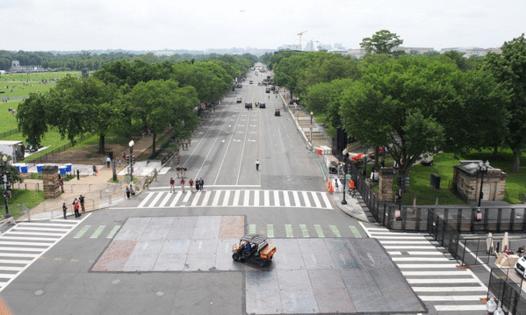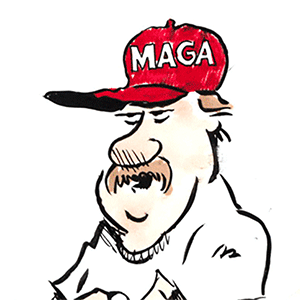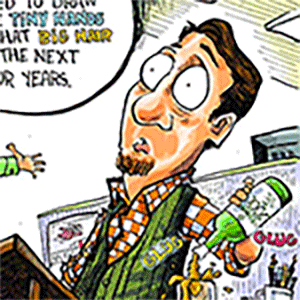Another kind of road warrior: Trump pitches asphalt for DC streets
Published in Political News
WASHINGTON — August has been a hot month for the asphalt industry, with President Donald Trump giving multiple shoutouts for petroleum-based pavement and promising to add asphalt layers to all the streets within 3 miles of the White House.
During an Aug. 13 news conference, the president disparaged concrete roads, poorly maintained streetlights and medians that look “horrible,” saying that “the roads are better in Armenia than they are in Washington, D.C. It’s embarrassing.”
Then on Aug. 22, Trump told reporters he’ll ask Congress for $2 billion and find “a great contractor” — naming Virginia-based Clark Construction Group LLC as his choice — to resurface D.C. streets with asphalt.
On both occasions, Trump called asphalt roads “beautiful” and concrete roads “no good” because they take years to construct and have problems “settling” after a rebuild.
“When you put a coat of asphalt on that — 2 inches of asphalt, 3 inches of asphalt — it looks brand new. … They take the bad stuff off and they put the good stuff down. It takes not a long period of time, a matter of a few days, and you’ll have a beautiful, magnificent road,” the president said.
“We’re going to head out right from the Capitol and the White House and if you look at a circle, and go about 3 miles out,” he said. “And we’re going to have this place beautified within a period of 12 months. The streets are going to be retopped.”
Aside from raising questions about whether Congress will provide the money and whether the D.C. Department of Transportation would go along with the plan, Trump revived an age-old debate about the best and most cost-effective way to build roads.
The National Asphalt Pavement Association celebrated Trump’s praise on Aug. 22 in a blog post by NAPA President and CEO Audrey Copeland.
“The President suggested that ‘for a relatively small amount of money’ our roads can be fixed. He’s not wrong,” Copeland wrote. “Asphalt is the most cost-effective solution for building and maintaining roadways.”
In an interview this week, Copeland and some of her NAPA colleagues elaborated on the benefits of asphalt.
“I think really what the president was getting at is the fact that when concrete reaches the end of its design life or its usefulness, you have to rip it out,” Copeland said. “Unfortunately, it’s not a layered system, whereas asphalt is a layered system. Therefore you can keep that foundation and then just, you know, add to the top few inches of it.”
Asphalt can last as long as concrete depending on the construction standards, said Richard Willis, NAPA’s vice president for engineering, research and technology.
“The reality is, the design life is actually in the hands of the engineer,” Willis said. “So you look at things like traffic, you look at the climate, and based on the materials that you have and on the kind of methodology you use, you can make an asphalt pavement last indefinitely.”
That’s one reason asphalt is used on more than 90% of roads in the U.S., along with the fact that it is easier to access cables and pipes beneath an asphalt surface in urban areas, construction time is far shorter than for concrete, and much of the surface material can be recycled when an asphalt road is rebuilt, Copeland said.
The American Concrete Pavement Association said Trump should take a closer look at concrete.
“We are confident he would be impressed with how quickly our members can construct first rate concrete roadways with materials that are durable, resilient and will last a lifetime,” ACPA’s senior director of technical services, Eric Ferrebee, said via email. “The concrete pavement industry boasts many innovations that directly align with the President’s construction objectives and we would hate for DC to sacrifice long-term performance by sidelining a major industry and construction material such as concrete pavement.”
“The President is spot on that Washington D.C. and the entire country need better roads,” a spokeswoman for the American Road and Transportation Builders Association, Beth McGinn, said via email. “Sometimes that means using concrete and sometimes that means using asphalt, and we look forward to working with the President and his team to deliver on that through the highway bill due next year.”
Both asphalt and concrete have environmental issues, particularly emissions of toxic fumes and greenhouse gases when either is produced, said Mike Williams, a senior fellow at the left-leaning Center for American Progress who has worked on programs aimed at cleaning up both materials.
Biden initiative
One program was the Buy Clean Initiative, established in the 2022 tax and climate law to provide $2 billion to states and industries to develop and purchase “American-made low carbon construction materials and products, including asphalt, glass, steel, and concrete for use in transportation projects.”
The Department of Transportation distributed $1.2 billion to 39 state transportation departments last November, but the Trump administration canceled the program days after he took office as part of its sweep of all climate-related initiatives from federal programs and regulations.
Williams noted that the asphalt association was an enthusiastic participant in the program, and research grants were already showing progress toward cleaner materials. Many states that received grants are continuing the work, which could ultimately bring market pressures to bear for greener projects, he said.
“Every state that has it in place has signaled that they are absolutely not walking back from it,” he said.
Williams views the administration’s decision to cancel the Buy Clean program — and the president’s promotion of asphalt over concrete — as both a nod to the petroleum industry and part of an obsession with erasing the previous administration’s climate work.
“There’s too many examples of this,” Williams said. “Where there’s a push against anything that could be ‘clean’ or ‘green,’ if you look just under the hood, the oil and gas industry and coal industry are there.”
During his first term, Trump fancied himself as the infrastructure president, regularly touting plans for rebuilding roads and bridges, Williams said.
“He didn’t do a damn thing. He was a huge failure. Biden comes in and passes the biggest infrastructure bill in our nation’s history. … Part of what’s keeping us from being in recession right now is the amount of federal dollars still flowing to construction projects, even though we’re starting to feel a slowdown in big metropolitan areas.
“But he then wants to prioritize paving the roads in a 3-mile radius around his house, where people around the country are like, ‘Well, we have other things that we need paved. Can we do that?'”
A spokesman for the D.C. Department of Transportation responded to Trump’s plans by referring to a statement on the agency’s website: “Mayor Muriel Bowser has committed to eliminating all poor quality roads eligible for resurfacing and absent of project conflicts in the District.” The site also includes a list of projects underway this month in the District.
Clark Construction, headquartered in McLean, Va., didn’t respond to questions about whether it has received a commitment from the federal government to pave streets in D.C. The White House said in July that Clark and engineering firm AECOM have been selected to build a $200 million ballroom on the East Wing of the executive mansion.
©2025 CQ-Roll Call, Inc., All Rights Reserved. Visit cqrollcall.com. Distributed by Tribune Content Agency, LLC.
























































Comments